It's horns are made from keratin!
Advertisement
Rhinoceros Scientific Classification
- Kingdom
- Animalia
- Phylum
- Chordata
- Class
- Mammalia
- Order
- Perissodactyla
- Family
- Rhinocerotidae
- Scientific Name
- Rhinocerotidae
Read our Complete Guide to Classification of Animals.
Rhinoceros Conservation Status
Rhinoceros Facts
- Main Prey
- Grass, Fruit, Berries, Leaves
- Habitat
- Tropical bushland, grassland and savannas
- Predators
- Human, Wild cats
- Diet
- Herbivore
- Average Litter Size
- 1
View all of the Rhinoceros images!

This horned mammal is one of the most endangered animals on Earth
The rhinoceros is an animal that was once found in Southeast Asia across Africa. Today, three rhino species are listed as “Critically Endangered” and clinging to small pockets of habitat.
With its distinctive horn and massive size, the rhino is one of the most unique animals on Earth. However, heavy poaching for its horn threatens several rhino species today.
Types of Rhino – The 5 Rhino Species

There are five separate species of rhino.
©JONATHAN PLEDGER/Shutterstock.com
There are five separate species of rhino that vary dramatically in size and anatomy. Today, the rhino is an animal that lives across Africa and Asia.
The largest species of rhino, the white rhinoceros, is an animal that is native to Africa. While the Southern white rhino has rebounded from the brink of extinction today, the Northern white rhino is now functionally extinct after the last male died in 2018.
Known for its triangular upper lip, the black rhinoceros is an animal that once roamed across nearly all of sub-Saharan Africa. However, today it’s critically endangered.
The largest rhinoceros native to Asia, the Indian rhinoceros has a range that extends across the foothills of the Indian subcontinent. The Indian rhinoceros has a distinct appearance with a single horn and skin that has the appearance of “body armor.”
Once found from India to the island of Borneo, today the Sumatran rhinoceros is critically endangered and located in just a few isolated pockets deep inside jungles.
While the Sumatran rhinoceros can still weigh up to 1,000 kilograms (2,200 pounds), it’s the smallest species of rhinoceros in the world. Sumatran rhinos are known for their prehistoric appearance, with hair that can cover their entire bodies.
Once roaming across Southeast Asia, The Javan rhinoceros today is limited to a single nature preserve in Indonesia named Ujung Kulan National Park.
Scientific Name
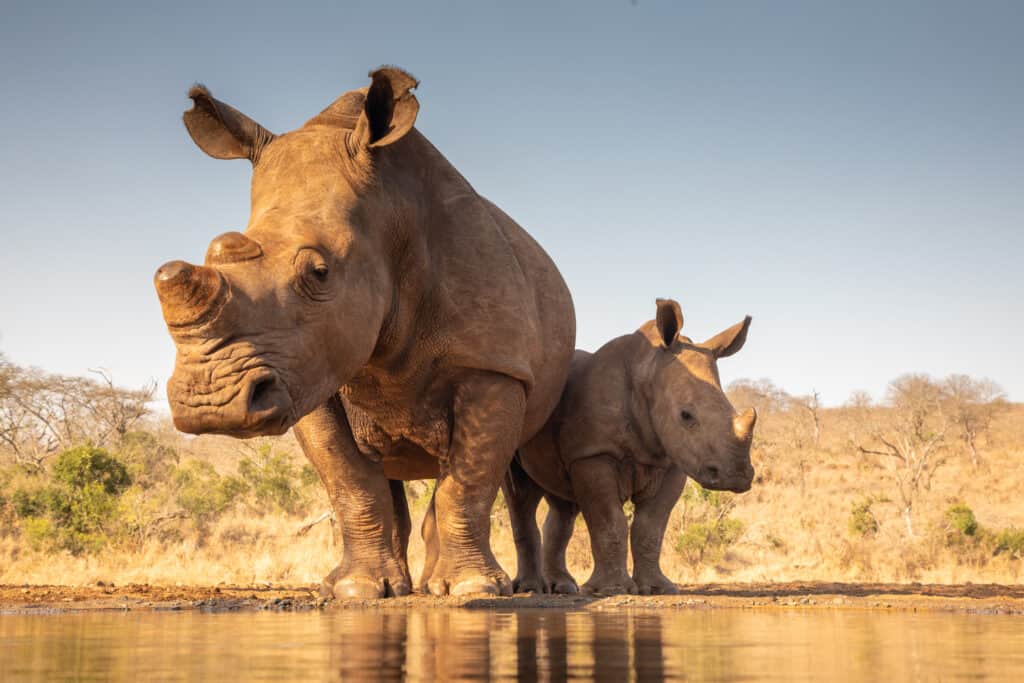
The name rhinoceros is derived from the Greek words that mean “Nose-horn”:
Rhinocerotidae©iStock.com/PeterVanDam
The name rhinoceros is derived from the Greek words that mean “Nose-horn.” The Rhinocerotidae family has five species with the following scientific names:
· Black Rhinoceros (Diceros bicornis)
· White Rhinoceros (Ceratotherium simum)
· Indian Rhinoceros Rhinoceros unicornis
· Sumatran Rhinoceros (Dicerorhinus sumatrensis)
· Javan Rhinoceros (Rhinoceros sondaicus)
Appearance and Behavior
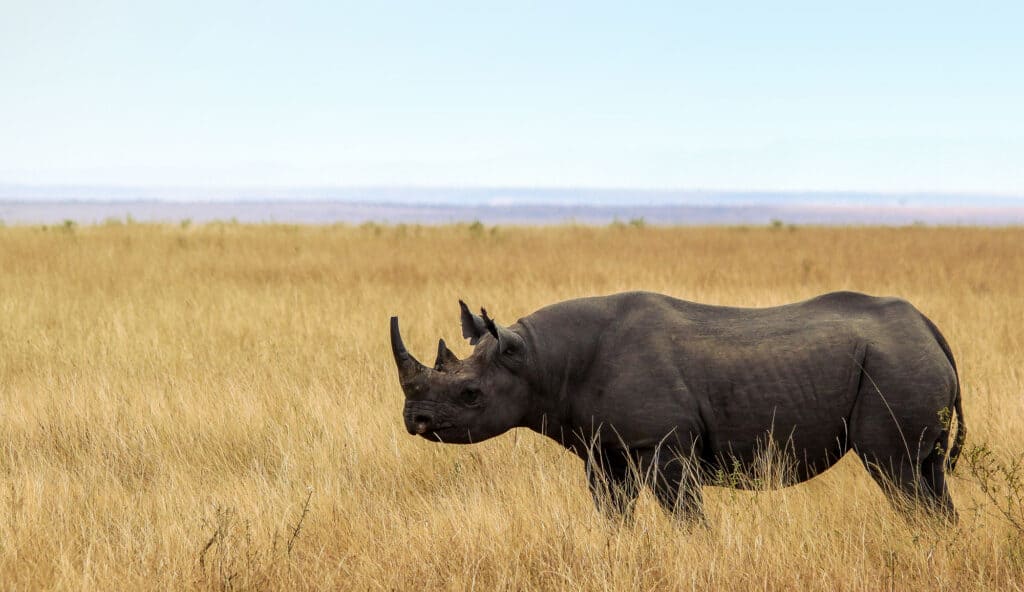
Rhinos are the second largest land animal, behind only the elephant.
©iStock.com/Black Rhinoceros, Rhinoceros, Savannah, Tanzania, Animal
Rhinos are the second largest land animal, behind only the elephant. The species first evolved during the Eocene – an era that ended about 33.9 million years ago – and are one of the last surviving “megafaunas.” That is animals that are massive by today’s standards.
They have a robust, cylindrical body with a large head, relatively short legs, and a short tail. The characteristic feature of these animals is a large horn in the middle of their faces; some species have a second, smaller horn.
Rhinos have brilliant hearing and the rhino also has a keen sense of smell, but the rhino is well known for having extremely poor eyesight. They are usually grey, black, or brown (though one species is called the “white rhino”).
Rhinos generally live a solitary lifestyle. Black rhinos will more aggressively defend their territory while Indian and Javan rhinos have more loosely defined territory that may overlap. Sumatran rhinos, which live in more dense forests and vegetation are diligent about marking trails with feces and urine.
Weight
Rhino species vary widely in length and weight but average about 1.5 tons (1,360 kg) in weight as adults. The largest species, the white rhino can weigh up to 3,600 kg (7,920 pounds), which makes it nearly four times the weight of the smaller Sumatran rhinoceros on average!
· White rhino: 1,440 – 3,600 kg (3,168-7,920 lbs)
· Black rhino: 800-1,400 kg (1,800-3,100 lbs)
· Indian rhino: 2,200 – 3,000 kg (4,900-6,600 lbs)
· Javan rhino: 900 – 2,300 kg (2,000-5,100 lbs)
· Sumatran rhino: 500 – 800 kg (1,100-1760 lbs)
Rhino horn
The most notable features of rhinos are the large horns that grow from their heads.
The horns of a rhinoceros are made of keratin, the same type of protein that makes up hair and fingernails in most animals including humans. Both the African species of rhino and the Sumatran rhinoceros have two horns, while the Indian rhino and Javan rhinoceros have just one horn.
Female Javan rhinos are notable in that they often lack a horn or have a smaller “bump” on their nose.
Unfortunately, rhinos face incredible pressure from poaching as their horn is desired for both traditional Chinese medicine and as a status symbol.
Longest rhino horns
In 2006, Dr. Nico van Strien conducted a study on the longest rhino horns by species.
- White rhino: 59 inches (150 cm)
- Black rhino: 51 inches (130 cm)
- Sumatran rhino: 32 inches (81 cm)
- Indian rhino: 23 inches (57 cm)
- Javan rhino: 11 inches (27 cm)
Rhino horns can grow in a variety of shapes. For example, a white rhino held in captivity in Sequim, Washington had a horn that grew to more than four feet in size that grew parallel to the ground. The horn grew so large it had to be trimmed twice using a chainsaw!
Groups of rhinos
While most rhino species are solitary, the white rhino is the most social of all species. Groups of a dozen or more white rhinos will often form. This behavior is particularly common among females with calves, as it can help mothers protect their offspring at a time they face greater threats from predators.
A group of rhinos is called a “crash.”
Habitat
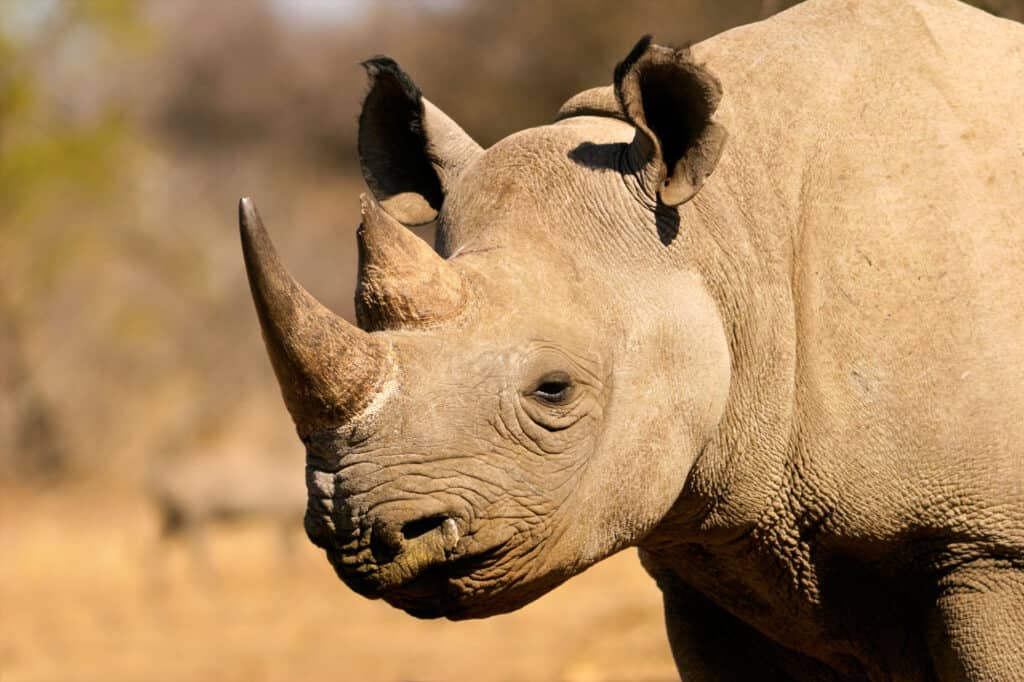
The rhinoceros is generally found in thick forests and savannas where there is plenty of food to eat and lots of covers for the rhino to hide in.
©iStock.com/EcoPic
The rhinoceros is generally found in thick forests and savannas where there is plenty of food to eat and lots of covers for the rhino to hide in. Rhinoceros’ once spanned a range that spanned across the majority of Africa and Southeast Asia, however today their range has been significantly reduced.
In Africa, the rhinoceros’ historical range was on grasslands and savannahs stretching across most of sub-Saharan Africa. Today, while black rhinos can still be found stretching from Ethiopia to South Africa, their populations are limited to smaller pockets on nature preserves and other protected areas.
The Sumatran and Javan rhino live in denser forests and once saw their range extend across all of Southeast Asia, however today the Javan rhino can be found in only a single nature preserve while the Sumatran rhino has few remaining pockets of the surviving population.
Like other rhino species, the Indian rhinoceros has seen its range dramatically decrease. It lives in tall grasslands and forests near the foothills of the Himalayas mountain range.
Population — How Many White Rhinos Are Left?
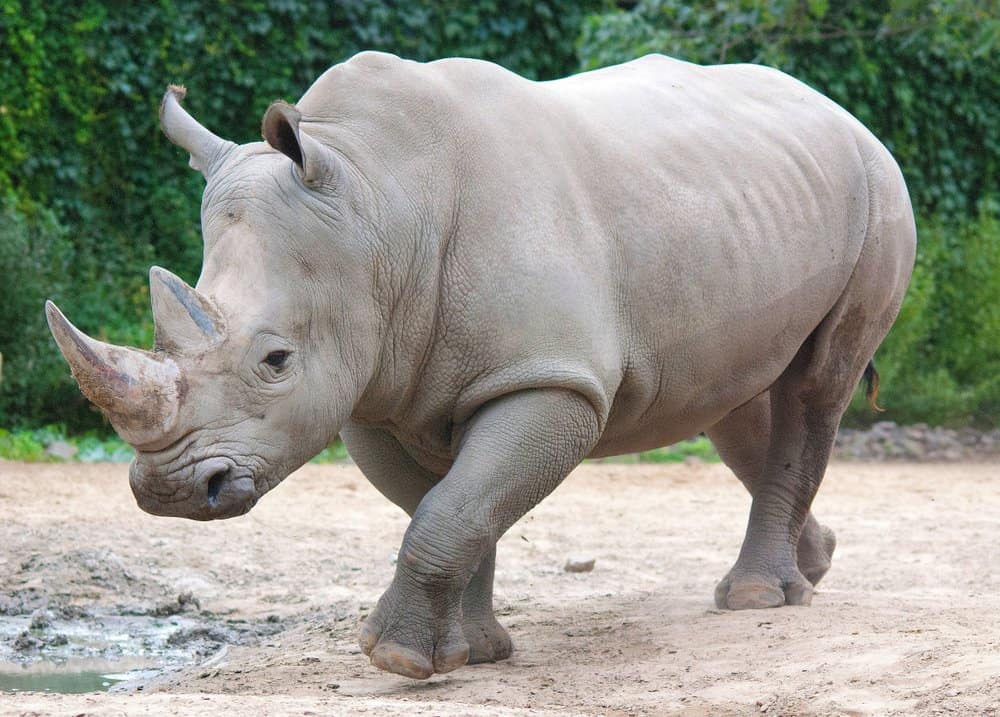
The white rhino is Near Threatened.
©meunierd/Shutterstock.com
Three rhino species – the black, Sumatran, and Javan – are listed as “Critically Endangered,” while the Indian rhinoceros is listed as “Vulnerable,” and the white rhino is “Near Threatened.”
According to the International Rhino Foundation, in 2019 there is the following populations of each species:
- White rhino: 18,000
- Black rhino: 5,500
- Indian rhino: 3,600
- Sumatran rhino: 80
- Javan rhino: 72
Four out of the five rhino species have seen their populations increase between 2009 and 2019.
The lone exception is the Sumatran rhino, which lives in isolated pockets and continues to suffer from poaching. Between 2009 and 2019 it saw its population decrease from an estimated 250 individuals to fewer than 80.
Evolution and Origin
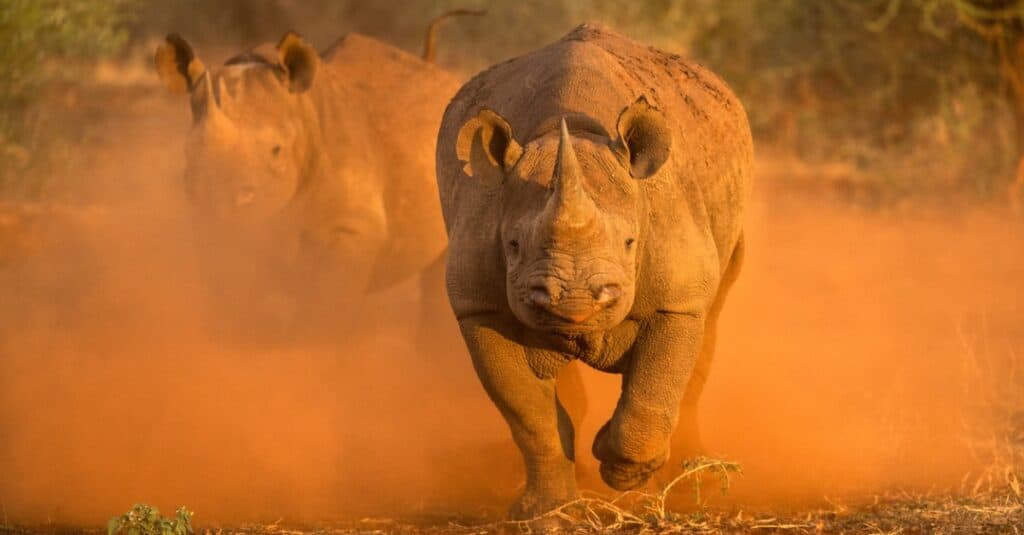
A rhino can gore an adult lion with its horn.
©iStock.com/Udo Kieslich
The rhino has been on Earth for a very long time. The family diverged from the tapir family about 55-60 million years ago. The family then evolved around a hundred different species around the world. Only nine of them survived to the Late Pleistocene age.
The species first appeared in the late Ecoscene in Eurasia. In fact, in contrast to their weight and size today, the eariest rhinos were actually small with a large population. There were 26 species of small ancient rhinos that lived in Eurasia and North America. This was until a wave of extinctions in the middle Oligocene wiped out many of the smaller species.
Extinct Species
No species of modern rhinoceros has gone extinct. However, numerous subspecies of rhinos have gone extinct in recent years. Historically, there were three subspecies of the Javan rhino, but only one remains after the last surviving Vietnamese Javan rhino was killed in 2010.
The Sumatran rhino subspecies in Malaysia were declared extinct in November 2019 after the last male and female died that year. The Northern white rhino is now functionally extinct after the last surviving male died in 2018. In 2011, the Western black rhino was declared extinct. There had been no sighting of the subspecies since 2001.
The last rhino species to go extinct was the Woolly rhinoceros (Coelodonta), which is believed to have gone extinct around 8,000 BC.
Predators
Rhinos face few predators in the wild. While juveniles can be attacked by large cats like lions or jaguars in addition to crocodiles and other larger predators.
Beyond the rhino’s imposing horn and significant size, the species also has a thick skin that serves as a form of natural “body armor.” Learn about the strongest animals in the world here.
The number one threat to rhinos remains poachers. In South Africa alone, 769 rhinos were poached in 2018. Rhino poaching varies by species, with no Javan rhinos having been poached in more than 25 years as of 2019.
Diet: what does the animal eat?
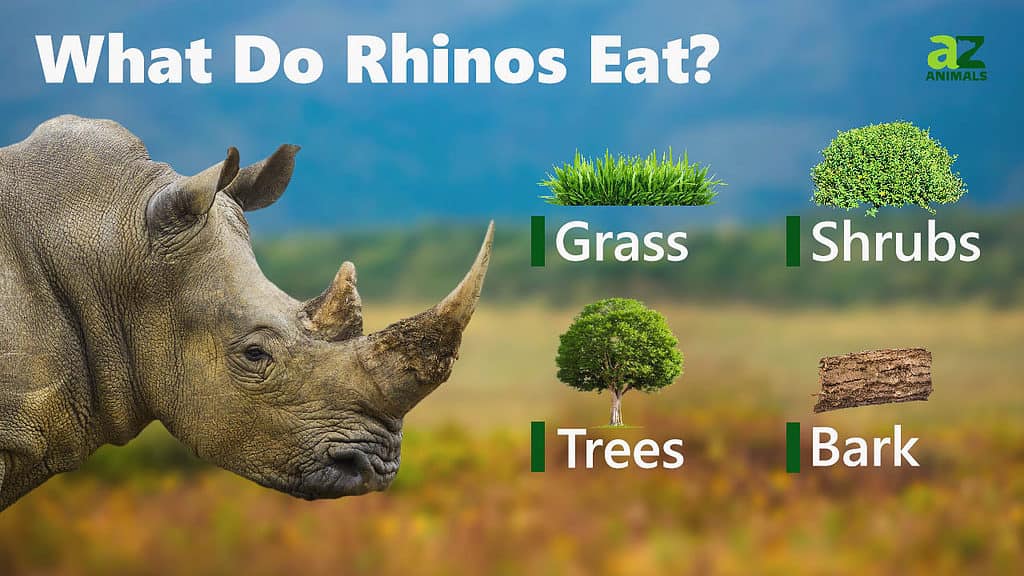
The rhinoceros is a herbivore and eats grasses, leaves, shoots, buds, and fruits in order to gain the nutrients that the rhino needs to grow and survive.
Although the rhino is a herbivore, they are known for their aggressive nature and will often charge toward oncoming predators in order to scare them away. Most rhinoceros individuals that are killed by poachers are caught out when they are quietly drinking from a water hole and therefore drop their guard. For a complete list of foods rhinos eat, check out our “What Do Rhinos Eat?” page.
Reproduction and Life Cycles
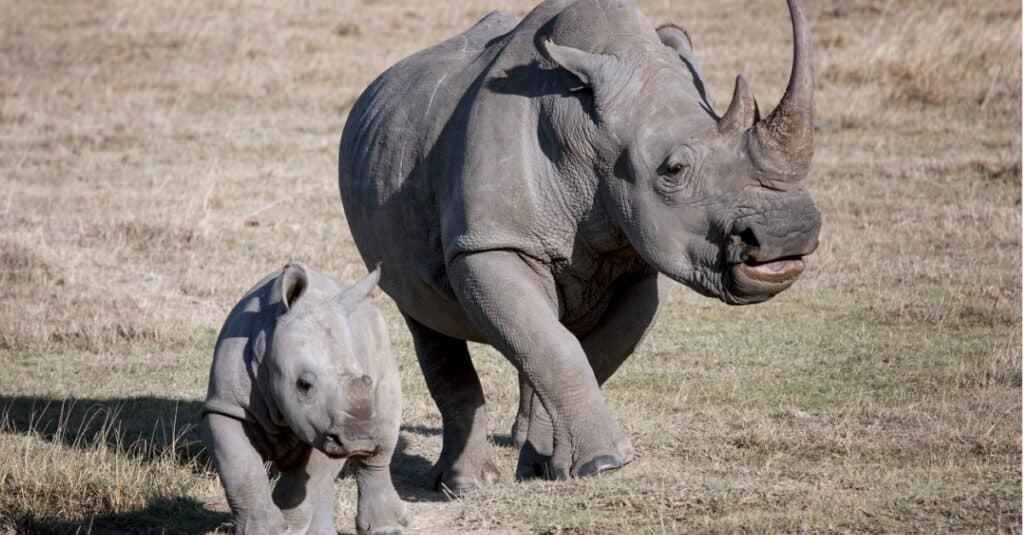
Rhinos are pregnant for a about a year and a half.
©iStock.com/robru
Rhinos have one of the longest gestation periods of all animal species at about 450 days. The longest reported captive gestation period was a white rhinoceros that was 548 days’ gestation (about 18 months).
This long gestation period means that rhinos typically don’t give birth again for an additional 3 to 5 years. This long gestation period and extended length between birthing new calves have made repopulating rhinoceroses an especially challenging problem.
How long do white rhinos live? The oldest white rhino in captivity lived to 55 while the oldest record of a black rhino was 52 years, and the oldest Indian rhino lived to 48. Generally, rhino species can live to be between 35 to 50 years old.
Incredible Rhino Facts
- An “armored” animal
- Rhinos have unique skin structures and materials that make them quite different from most mammals. Compared to their body size, rhino skin is three times thicker than predicted and contains crosslinked collagen fibers. At its thickest, rhino skin can be about 2 inches (5 cm) thick.
- What’s in a rhino horn?
- The horn of a rhino is made of hair grown tightly together, while a natural “glue” from glands on the rhino’s nose packs these hairs tightly together. You may have heard rhino horns are made of the same material as your fingernails, that’s because rhino horns contain tubules of keratin, a protein found across hair, skin, and nails.
- Today, 85% of rhinos live in just one country
- While rhinos historically roamed across most of sub-Saharan Africa and SE Asia, today an estimated 85% of living rhinos are located in just one country: South Africa.
- From a million black rhinos to 5,500 today
- It was estimated that at the beginning of the 20th century, more than a million black rhinos lived across Africa, today their population numbers just 5,500 individuals. While that population loss is staggering, the black rhino population continues to rebound.
- Why did rhino poaching skyrocket?
- Between 1960 and 1995, 98% of black rhinos were killed by poachers. This upswell in poaching can be traced to China’s Chairman, Mao Zedong, promoting the return of traditional Chinese medicine which utilized rhino horns as a cure. Today, strict bans have slowed rhino horn trade in China, while demand in Vietnam has led to a spike in poaching.
- Two of the most critically endangered large mammals in the world
- With less than 100 individuals, the Sumatran rhinoceros and Javan rhinoceros are two of the most critically endangered large mammals in the world. While the Javan rhino population has stabilized in recent decades, some estimates believe there could be as few as 30 Sumatran rhinos surviving today.
- There is hope for even the most endangered species
- Thanks to incredible conservation efforts there are hopes for rhino species. The population of black rhinos has doubled this century. White rhinoceros populations have rebounded from about 50 rhinos to nearly 20,000 individuals. In addition, the Indian rhino has rebounded from less than 100 individuals to a population of about 3,600 today.
- Nearly a quarter of rhinos live on private game reserves
- Today, more than 5 million acres of private game reserves house 6,500 rhinos or about ¼ of the entire rhino population.
- Illegal rhino horn trade goes beyond poaching
- While the illegal trade in rhino horns has led to significant poaching across the past decade, thieves have targeted rhino horns from unusual places. In 2011, thieves robbed a museum in Dublin, stealing four rhino horns from a museum. It’s estimated the robbery could be sold for $650,000 on black markets. In addition, in 2011 a rhino horn was stolen from a museum in Ipswich, England. Between 2002-2011 there were more than 20 reported cases of thieves robbing rhino horns from museums.
- Fighting Back
- Beyond protecting rhinos on reserves where rangers and other (often armed) guards can protect rhinos, there are conservations efforts underway to protect rhinos in unique ways like dying their horns with red dyes, 3D printing horns to depress the price of rhino horns, and even introducing rhinos into new environments and private reserves.
- You can help with the fight to save the rhino
- There are numerous organizations dedicated to helping rhino conservation efforts. These efforts include Save the Rhino (savetherhino.org) and the WWF (worldwildlife.org)
Rhinoceros FAQs (Frequently Asked Questions)
Who would win in a fight between a rhino and a hippo?
In a fight pitting rhinos vs. hippos, the winner would depend on where they met. On land, a rhino could use its charging power and horn to successfully attack a hippo. Near water, the hippo would have the advantage.
Are rhinos related to dinosaurs?
While rhinos may bear a resemblance to dinosaurs such as the Triceratops, the two types of animals are not related. Dinosaurs were reptiles while rhinos are mammals.
How long can rhino horns grow?
The largest ever recorded rhino horn was 59 inches and found on a white rhino. In general, rhino horns are about 20 inches in length but vary by species.
How fast can a rhino horn grow?
Rhino horns can grow back in about three years. Rhinos are often de-horned as a preventative measure against poachers, but it’s important to leave a portion of the rhinos horn for it to re-grow.
What is a rhino horn made of?
The horn of a rhino is made of hair grown tightly together, awhile a natural “glue” from glands on the rhino’s nose packs these hairs tightly together. You may have heard rhino horns are made of the same material as your fingernails, that’s because rhino horns contain tubules of keratin, a protein found across hair, skin, and nails.
Do rhinos have body armor?
Rhinos have unique skin structure and materials that make it quite different from most mammals. Compared to their body size, rhino skin is three times thicker than predicted and contains crosslinked collagen fibers. At its thickest, rhino skin can be about 2 inches (5 cm) thick.
What rhino species is the most endangered?
As of 2019, the Javan rhinoceros population is estimated at 72 individuals while there are less than 80 Sumatran rhinos. Because the Sumatran rhino population is significantly more spread out, they’re regarded as the most endangered of all species.
Where can I find a rhino?
As of December 2018, there were 302 zoos with 1,037 rhinos. The most common rhino in zoos is the white rhino, followed by the black. As of 2015, the last Sumatran rhino in the Western Hemisphere was moved from the Cincinnati Zoo back to Indonesia.
What food do rhinos eat?
Rhinos are herbivores and eat grasses, leaves, shoots, buds and fruits. Different rhino species have evolutionary features that are adapted to their diet. For example, the white rhino has a square
What is a group of rhinos called?
Most rhinos are solitary animals, but white rhinos will congregate into groups that can exceed a dozen individuals. When a group of rhinos forms, it’s called a “crash.”
What was the largest rhino?
An extinct rhino species that lived 34-23 million years ago stood 16 feet at its shoulder and weighed an estimated 20 tons! Today the largest rhino species is the white rhino, which weights up to 7,920 lbs (3,600 kg).
What is a rhino’s top speed?
Rhinos have reported top speeds that generally range from 30 miles per hour up to 35 miles per hour (48 km/h to 56 km/h). The San Diego Zoo reports black rhinos can reach up to 40 miles per hours (64 km/h).
What Kingdom do Rhinoceroses belong to?
Rhinoceroses belong to the Kingdom Animalia.
What phylum do Rhinoceroses belong to?
Rhinoceroses belong to the phylum Chordata.
What class do Rhinoceroses belong to?
Rhinoceroses belong to the class Mammalia.
What family do Rhinoceroses belong to?
Rhinoceroses belong to the family Rhinocerotidae.
What order do Rhinoceroses belong to?
Rhinoceroses belong to the order Perissodactyla.
What type of covering do Rhinoceroses have?
Rhinoceroses are covered in Leathery skin.
What are some predators of Rhinoceroses?
Predators of Rhinoceroses include humans and wild cats.
What is the average litter size for a Rhinoceros?
The average litter size for a Rhinoceros is 1.
What is an interesting fact about Rhinoceroses?
Rhinoceros horns are made from keratin!
What is the scientific name for the Rhinoceros?
The scientific name for the Rhinoceros is Rhinocerotidae.
What is the lifespan of a Rhinoceros?
Rhinoceroses can live for 35 to 50 years.
What are the differences between a rhino and a triceratops?
The greatest differences between a triceratops and a rhino are their morphology, size, and location.
Thank you for reading! Have some feedback for us? Contact the AZ Animals editorial team.
Sources
- David Burnie, Dorling Kindersley (2011) Animal, The Definitive Visual Guide To The World's Wildlife
- Tom Jackson, Lorenz Books (2007) The World Encyclopedia Of Animals
- David Burnie, Kingfisher (2011) The Kingfisher Animal Encyclopedia
- Richard Mackay, University of California Press (2009) The Atlas Of Endangered Species
- David Burnie, Dorling Kindersley (2008) Illustrated Encyclopedia Of Animals
- Dorling Kindersley (2006) Dorling Kindersley Encyclopedia Of Animals
- David W. Macdonald, Oxford University Press (2010) The Encyclopedia Of Mammals

















